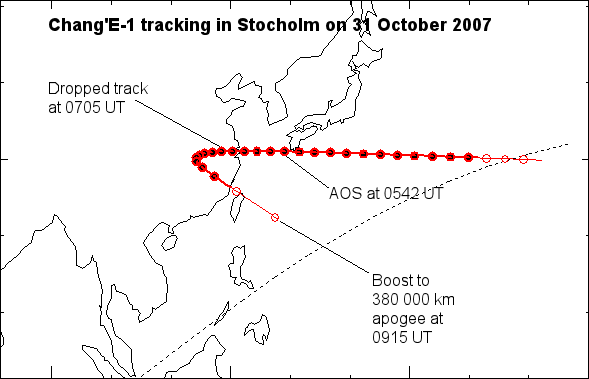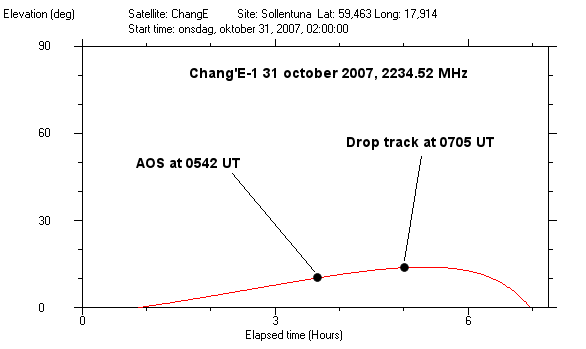Tracking Chang’E-1 from Sweden
Sven Grahn
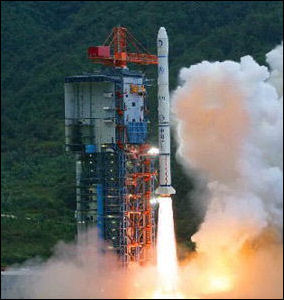 Chang'E-1, China's first lunar probe, was launched at
1005 UT on October 24 on a
Chang-Zheng 3A from the Xichang launch site in the Sichuan province.
Its initial orbit was
221-50602 km at 31.0 degrees inclination. On the 25 th the
perigee was raised and the orbit
became 584-50566 km (1.5 days period), still at the same
inclination. By Oct 26 the orbit had been raised to 594-71317 km
(one-day period).
Chang'E-1, China's first lunar probe, was launched at
1005 UT on October 24 on a
Chang-Zheng 3A from the Xichang launch site in the Sichuan province.
Its initial orbit was
221-50602 km at 31.0 degrees inclination. On the 25 th the
perigee was raised and the orbit
became 584-50566 km (1.5 days period), still at the same
inclination. By Oct 26 the orbit had been raised to 594-71317 km
(one-day period).
Before launch I had checked the ITU
filings of China and found these
frequencies listed for an object called CE-1: 2209.80, 2234.52,
2254.00, 2280.00, 2287.00 MHz. Dick Flagg in Honolulu was the first to
pick up Chang'E-1 at 2230 UT on October 24 on 2234.533 MHz.
Shortly
thereafter also Grady Whitney in Texas. After that, the following
day, Bob Christy in the UK and Greg Roberts in South Africa also
picked up the signal. Dick Flagg observed up to 5 sidebands visible on
either side of the 2234.52
MHz carrier.
Strength compared to main carrier as
follows:
+/- 33kHz weak
+/- 66 kHz strong (almost equal to
carrier strength)
+/- 99 kHz moderately strong
+/- 132 kHz very weak
+/- 165 kHz weak
Chang'e-1 increased its Earth orbital
apogee to
120000 km (2-day period) on October 29 at 1001 UTC, and again to a
380000 km
apogee at 0915 UTC on
Oct 31. It entered a 210-8600 km polar lunar orbit at 0337 UT on
November 5.
27 October 2007
When I switched on
the receiving system in the morning (local time) on 27 October
2007 I had little hope of picking up anything from the Chinese lunar
probe Chang’E. The elevation above my horizon would barely touch the 30
degree lower limit of my helix coverage. But I immediately picked
up a weak carrier and set the SDR-14 to move really slowly so
that I could get a good overview of the Doppler curve. I had to do
gardening work (cutting a high hedge) during the hours before noon, but
when I came into the house at 0920 UT after finishing the hedge work I
saw that there had been a frequency shift, a Doppler maximum and
Loss-Of-Signal. I had run predictions for Doppler shift and elevation
angle using the original element set for Chang’E (actually a secondary
object but it had roughly the same orbit as the moon probe) and those
predictions showed no Doppler maximum or setting below my horizon
before 1000 UT. Clearly, if this was Chang’E, the orbit must have
changed. I logged into Space-Track and found that this was indeed so. A
simulation with the new orbital elements confirmed that I had indeed
seen Chang’E (read more here).
The Doppler maximum occurred at about 0850 UT. What happened? Somebody
manipulated the uplink and a second maximum appeared! The signal
strength was low, because the spacecraft was near the lower elevation
limit of my 3.5 turn helix – 30 degrees.
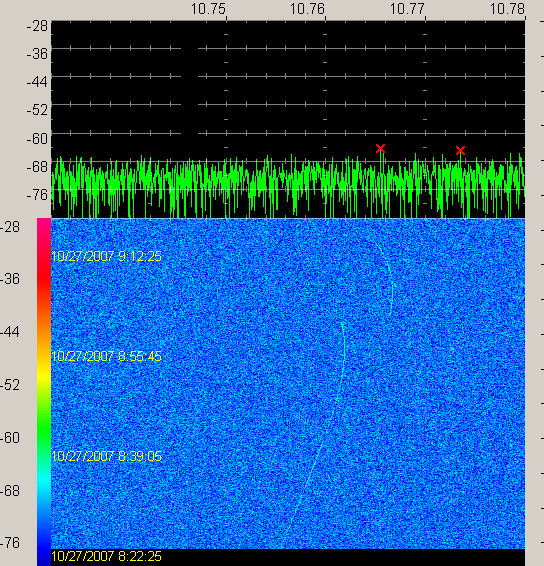
Here are the elevation and Doppler
plots for the morning hours (UT) of 27 October 2007 using the element
sets after the first big orbital maneuver. But the frequency was much
higher at Doppler maximum than predicted by the software for
non-transponder operation, the observed value was 2234.58 MHz. The
Doppler shift without transponder action would have been +28 kHz and
with transponder mode about twice that, which corresponds roughly to
the frequency observed.
28 October 2007
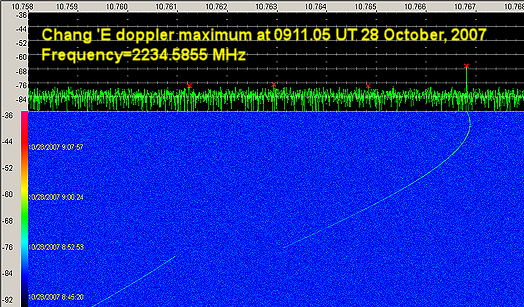 I went on watch at 0609
UT, and found a carrier present at 2234.554 MHz. I Set SDR-14 at
10 kHz filter bandwidth and 4 secs/update..... FFT Average=2, skip N=2
updates. Carrier/Noise (C/N) then came out nicely at 8 dB.
I went on watch at 0609
UT, and found a carrier present at 2234.554 MHz. I Set SDR-14 at
10 kHz filter bandwidth and 4 secs/update..... FFT Average=2, skip N=2
updates. Carrier/Noise (C/N) then came out nicely at 8 dB.
- At 0732 UT fx=2234.564 MHz
- At 0849 UT fx=2234.5805 MHz
- At approx 0852 UT there was another jump in
frequency indicating a change of G/S. The received frequency jumped + 2
KHz and doppler rate increased noticeably. I wonder which station got
the baton. Was it a station closer to the spacecraft subsatellite
point?
- At 0901 UT fx=2234.5855 MHz
- At 0903 UT C/N=15 dB
- At 0910 UT C/N=20 dB
- Doppler maximum at 0911.05 UT fx=2234.5868 MHz
- Loss-Of-Signal at approx 0918 UT, fx=2234.5856
MHz. The calculated elevation at LOS was 14 degrees.
The spectrogram on
the right shows the frequency change at ground station handover and the
Doppler maximum.
29 October 2007 - Chang'E picked up
just before another raising of the apogee
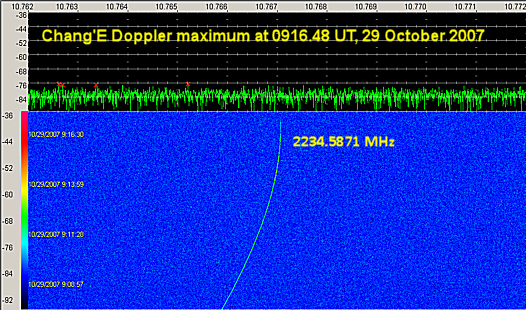
I switched on the tracking gear as soon as I had finished
breakfast. The signal from Chang’E was there at 0652 UT on 2234.558 MHz, very weak
coming out of the noise. It kept fading in and out but finally near 0900 UT the
signal strength improved and the Doppler curve showed signs of
approaching a maximum.As the morning passed, I thought I had
lost it, but finally the signal strength grew and the Doppler reached a
maximum:
- At 0822
fx=2234.573 MHz
- At 0859
fx=2234.584 MHz
- At 0902
fx=2234.5846 MHz
- At 0908 C/N=13
dB
- At 0912 C/N= 15
dB
- At 0913 C/N= 18
dB, 2234.5869 MHz
- At 0915 C/N= 19
dB, 2234.5870 MHz
- At 0910 C/N= 20
dB
The maximum occurred at 0916.48 UT at the frequency
2234.5871 MHz, about 6 minutes later than the day before. The signal
rapidly faded after that at disappeared at 0917.30 UT, almost exactly
as the day before...so still no maneuver. Chinese media announced that a maneuver to a 48-hr orbit
with apogee at 120000 km was planned and it was reported to have
occurred at 1001 UT, 43 minutes after I lost the signal. Would I be
able to pick it up when it comes back to earth in two days?
Bob Christy found out that the
maneuver to the 48-hr, 120,000 km apogee orbit took place at 1001 UT
(See map below). He also found a Chinese paper in which the equivalent
isotropic power of the transmitter is 20 Watts with a possible increase
by 5 dB in lunar orbit. Some simple arithmetic shows that a 20 dB dish
should be sufficient to see the carrier in lunar orbit.
 Chang'E-1, China's first lunar probe, was launched at
1005 UT on October 24 on a
Chang-Zheng 3A from the Xichang launch site in the Sichuan province.
Its initial orbit was
221-50602 km at 31.0 degrees inclination. On the 25 th the
perigee was raised and the orbit
became 584-50566 km (1.5 days period), still at the same
inclination. By Oct 26 the orbit had been raised to 594-71317 km
(one-day period).
Chang'E-1, China's first lunar probe, was launched at
1005 UT on October 24 on a
Chang-Zheng 3A from the Xichang launch site in the Sichuan province.
Its initial orbit was
221-50602 km at 31.0 degrees inclination. On the 25 th the
perigee was raised and the orbit
became 584-50566 km (1.5 days period), still at the same
inclination. By Oct 26 the orbit had been raised to 594-71317 km
(one-day period).






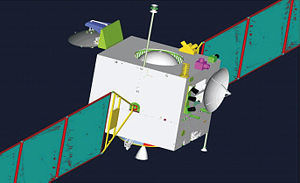 Chang'E-1 came back
to Earth's vicinity
from the 120000 km apogee early on 31 October 2007. I gambled on the
possibility of picking up signals and did so on
Chang'E-1 came back
to Earth's vicinity
from the 120000 km apogee early on 31 October 2007. I gambled on the
possibility of picking up signals and did so on 